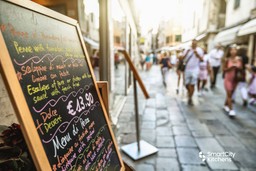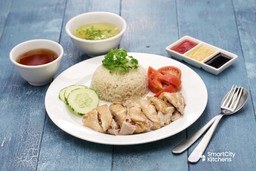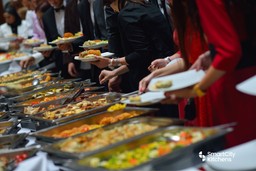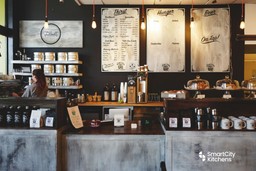Menu pricing plays an integral part in a restaurant’s success. It needs to be competitive enough to not only outshine the numerous competitors but also enticing enough that it woos the customers and keeps them coming back regularly.
Given the unprecedented times, the F&B industry in Singapore is going through, menu pricing has never been more important and will continue to be a key focal point for restaurants and CloudKitchen® delivery kitchens going forward.
You might be thinking about how to ensure the prices on your menu are attractive. Well, don’t sweat because we at Smart City Kitchens have got you covered with an all-encompassing guide that touches on everything you need to know.
How do you price your menu?
Pricing your menu is done through a well-thought-out process that requires you to calculate a few key things, as this will help ensure you make a profit on every dish you sell.
The main methods are to calculate:
- Food cost percentage, or
- Gross profit margin
What’s your food cost percentage
Identifying your food cost percentage for items on your menu is essential. Let’s say you are running a Singaporean-themed restaurant, and one of your star delicacies is Hainanese chicken rice. You have to decide your food cost and stick to it. So, in this instance, let’s put the food cost at 25%.
Figure out the cost of goods sold (COGS)
Now that you have a food cost percentage in mind, you need to actually take a look at how much it costs to prepare the Hainanese chicken rice dish from scratch. Include all the raw ingredients, plus the sauces you will need to use. Let’s assume it costs S$5 for a single portion. Now you will need to use the formula to calculate how much your food should be priced.
Input everything into the formula
You should use the following formula for your menu pricing:
Price = COGS / Ideal Food Cost
Price = S$5.00 / .25
Price = S$20
Using the formula, you now know that you need to sell Hainanese chicken rice at S$20 to hit your food’s cost goal of 25%.
This isn’t the only way to figure out your menu pricing, though, as there is another method you can use.
Menu pricing through gross profit margin
Gross profit margin is the percentage of total sales made from one dish that is profit. Let’s keep using the Hainanese chicken rice dish as an example and say that it has a profit margin of 30%. That means 30 cents out of every dollar spent creating the dish is profit.
How to use gross profit margin to determine menu pricing
You can use a simple formula to ascertain what price a dish should cost on your menu. But before jumping into this, you need to know three things:
- the menu price of each item,
- the raw food cost, and
- the gross profit margin you want on that particular dish.
So, for our Hainanese chicken rice, you might want it on the menu at S$15, and the cost to make it is S$5, as mentioned before. You may also want the profit margin to be 60%.
When put into the formula, it will look like this:
Gross Profit Margin = (Menu Price – Raw Food Cost) / Menu Price
Gross Profit Margin = (15 – 5) / 15
Gross Profit Margin = 66.6%
By pricing your Hainanese chicken rice dish at S$15 on the menu, you will actually be making a profit of over 60%, which is brilliant!
Buffet menu pricing
When it comes to buffets, we have to keep a couple of key things in mind, including:
- Customers will generally eat around one pound of food
- The total cost of raw materials needed for that one pound of food (COGS)
- Your ideal food cost or gross profit margin
Let’s say one pound of food has a COGS of S$10, which includes everything from meats to side items like french fries. If you want an ideal food cost of 30%, you need to use the following formula:
Price = COGS / Ideal Food Cost
Price = S$10 / .30
Price = S$33.3
If you want a gross profit margin percentage of 80% and put your restaurant’s buffet pricing at S$20 on your menu, you can use this formula to calculate whether you will achieve your gross profit margin goal.
Gross Profit Margin = (Menu Price – Raw Food Cost) / Menu Price
Gross Profit Margin = (20 – 10) / 20
Gross Profit Margin = 50%
So in this case, you have a clear indication that you need to increase the price of your buffet in order to hit that 80% gross profit margin figure. To attain that objective, the cost of your buffet has to be increased to S$50.
Factors that can influence your menu pricing
There are plenty of factors that can directly impact your menu pricing. This can range from the fluctuating costs of ingredients to competitor prices too. To ensure your restaurant’s menu shines, captures your customers’ attention and remains profitable, here are some things to keep in mind.
1. Direct costs
Direct costs are simply how much you pay for your raw materials and should definitely be considered when pricing items on your menu as it incorporates a few key components, including:
- The amount of money paid for the raw materials, not including labour and transportation costs
- Food waste costs, which include the cost of any food and raw materials that aren’t eaten or used
- Portion size costs, which will vary from dish to dish
If your direct costs are high, your menu pricing must be increased to maintain an acceptable profit percentage.
2. Indirect costs
Labour costs are the first thing that should come to mind when considering indirect costs. If you run a traditional brick-and-mortar restaurant, your staff costs will be significantly higher compared to a business run out of a CloudKitchen® delivery kitchen.
In addition to the salaries you pay your employees, indirect costs include everything else needed to prepare the dishes on your menu, except raw materials. This includes pots, pans, cutlery, lighting, water, gas, etc.
3. Customer psychology
Customer psychology is extremely important in menu pricing as you want to ensure they feel they are getting value for money. If the dishes on your menu are too expensive, your diners will go somewhere else to eat.
Similarly, if you price items on your menu too cheap, your customers may become suspicious about the quality of your food and potentially your hygiene standards too. Therefore, it is essential to find the right price that keeps your patrons enticed enough to keep coming back.
4. Menu engineering
The whole concept of menu engineering revolves around getting the most profit out of the food items that are the biggest sellers.
In a nutshell, you want to achieve two things when using menu engineering:
- Lower the food costs associated with the top-selling items on your menu
- Make those dishes more visible on your menu with attention-grabbing promotions and discounts
To accomplish this, you would need to conduct an in-depth look into your costs, profit margins and sales patterns. While it may sound like a lot of work, you will reap the rewards if you get it right!
5. Competitor pricing
Regardless of whether your restaurant or CloudKitchen® delivery kitchen is in Singapore or another country, you will definitely have other competitors. As a result, you must know what your competitors are charging for their dishes to ensure your prices reflect that and keep you highly competitive.
If your food items are more expensive and offer no obvious unique selling point, then your customers will frequent your competitors. However, if there is something that makes your food stand out from the crowd, the local community may think it’s worth the higher price tag.
Essentially, it all boils down to making sure you make as much profit as possible on every dish you sell. If your prices are higher than your competitor’s, try and find ways to reduce your food costs without sacrificing quality and flavour.
The price is right
Menu pricing can make or break your restaurant or CloudKitchen® delivery kitchen, so make sure you keep your cost of goods sold (COGS) and gross profit margin in mind for every item you offer to the public. Be aware of your direct and indirect costs and what your competitors charge for similar dishes. If you can do this, your F&B business will be a roaring success! Should you require more information about creating an appetising menu, everything you need to know can be found here.
If you are interested in launching your own CloudKitchen® delivery kitchen, fill out the form below to get in touch with us today!







